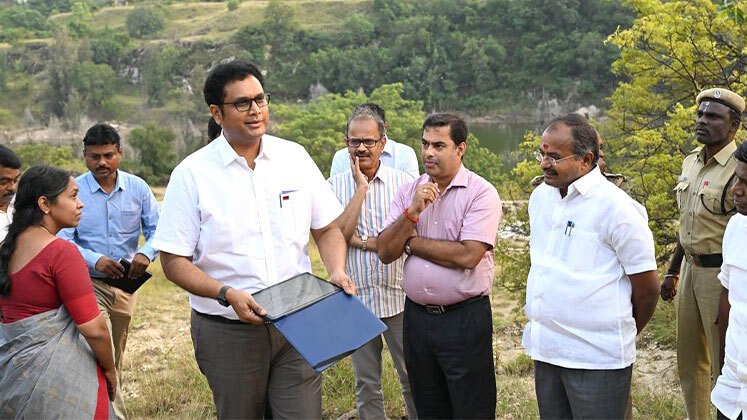
The 119-acre textile park at Tamil Nadu’s Jahir Ammapalayam, once promoted as a major driver of employment and industrial growth in Salem, has now become a focal point of public concern and uncertainty. Residents, who had anticipated only value-addition units, say they recently learnt that the park will also house dyeing units — a development that has raised significant environmental fears.
Announced in 2021 as a Rs. 880 crore (US $ 99.36 million) project, the park is now meeting strong resistance from locals. They allege they were never clearly informed about the inclusion of dyeing units, which fall under the Red category of industries, and claim that no proper public consultation took place. Even the park’s formal name — Salem Yarn Colouring Park (SYCP) — surfaced only in recent days, amplifying unease among communities living nearby.
Given the site’s proximity to a pond, key groundwater sources, and farmlands — and considering Salem’s highly absorbent magnesite-rich soil — residents fear that even minor effluent leaks could contaminate groundwater and severely impact the local ecology.
Arun Kumar M, secretary of the Salem Water Sources Protection Movement, stated that there was a lack of transparency surrounding the project. He questioned why the facility was initially described as a textile park if its primary function was always intended to include colouring activities. He also raised concerns over SYCP chairman A. Alagarasan’s position on the Tamil Nadu Pollution Control Board, expressing doubts about impartial oversight. He remarked that effluent treatment plants had failed in other regions and questioned how Salem would be any different.
Despite their concerns, residents maintain that they are opposing only the establishment of a Red category industry within corporation limits without proper disclosure or consent.
The growing discontent became evident when the planned inauguration of SYCP’s administrative block on 7th November — an event expected to feature three cabinet ministers — was abruptly postponed following widespread protests.
District Collector R. Brindha Devi responded to the criticism, asserting that the project was not new and that dyeing units had always been part of the plan. She expressed surprise at the sudden opposition, stating that residents should have expected such units within a textile park.
T. Sashikumar, Joint Managing Director of SYCP, said there was a misconception among the public that the integrated textile park would consist solely of dyeing units. He explained that weaving units and other operations were also planned, with dyeing forming only one component of the larger project. He added that SYCP had applied for Tamil Nadu Pollution Control Board (TNPCB) clearances and that only land-levelling work was currently under way.
However, a senior SYCP official confirmed that the detailed project report (DPR) was still under preparation and would require at least 15 more days to complete. TNPCB officials also said they had not yet received the DPR for evaluation or approval.
Although officials have indicated that the park is expected to accommodate around 20 dyeing units, 20 weaving units and 10 garment units, this remains only an informal outline for now.






